In response to: “A rebuttal to COHA’s article ‘The Unfulfilled Promise of Informed Consent in Mining Projects’”
In response to Newmont Mining Rebuttal to Erika Quinteros’ article “The Unfulfilled Promise of Informed Consent in Mining Projects”
By Lynn Holland, PhD, Senior Research Fellow at the Council on Hemispheric Affairs
To download a PDF version of this article click here.
Many in the province of Celendín, affected by the Conga mine owned by Newmont, wanted to hold an official vote but the national government said that it would not be valid and no funding support was available. Nonetheless, an IPSOS survey in 2012 showed that 78 percent of the Cajamarca population were against the Conga project and the community voted in a mayor based on their anti-Conga position in 2014.
As for consultation, the public consultation meeting was held in a different province and, as reported by Jose De Echave, former Minister of the Environment, was largely attended by people paid by Yanacocha (run by Newmont) to sign their approval for the project. Nor was it open to the public and those who found out about it from Celendín who travelled to be there were not allowed in. (José de Echave, et al. (2013) ‘Minería y movimientos sociales en el Perú: Instrumentos y propuestas para la defensa de la vida, el agua y los territorios’, Lima: Depósito Legal en la Biblioteca Nacional del Perú No. 2013-13306)
As development specialist Lynda Sullivan writes, “The ‘audience’ took place in La Encañada, in the province of Cajamarca, despite the fact that 80 percent of the effects of Minas Conga would be felt in the province of Celendín. The vast majority of Celendín citizens, including those living nearest to the proposed Conga site, were not even informed about the existence of the EIA, never mind an event to present its contents. Yanacocha claims that 31 out of 32 affected communities were consulted; campaigners claim the actual number of communities affected would be 200 – and most of them were not consulted.”
As for the situation at hand, the destruction of the head of the water basin would affect all those living downstream and not just in the area that would become the site for the open pits and the toxic waste dumps. Five rivers stem from Conga and these would all be affected. That hundreds of thousands would be affected and only 31 communities apparently consulted, raises serious questions about the consultation process as it took place.
The communities of Cajamarca and the Rondas Campesinas have recently brought a case to the Inter-american Commission of Human Rights based on their indigenous status.
By Lynn Holland, PhD, Senior Research Fellow at the Council on Hemispheric Affairs


